Big Display Boards for Top Fairs
At some top science fairs, like the Regeneron International Science and Engineering Fair (ISEF), big display boards are the norm. We define "big boards" as those substantially larger than the standard, three-panel display board that unfolds to be 36" tall by 48" wide.
Important! Before planning your display board, be sure to check the rules for your fair to make sure that you do not build a board that is too large.
While a large board gives you additional room to describe your project, it also can become hard to transport. Don't laugh, but we have met students who made boards that were small enough to meet the fair guidelines, but unfortunately too big to fit into their own car! So, a big board can be a big problem. It can be even more challenging if you have to ship your board to a distant city.
Based on actual experiences with transporting boards across town and across the country, parents among the Science Buddies staff are strong supporters of "modular" construction techniques for making big boards. In other words, a big board that can be transported as smaller pieces that are assembled at the fair itself. This creates the best of all worlds: a board that is easy to transport, but large enough to hold all the information for any project.
Modular Display Boards
Modular display boards use the standard 36" x 48" Foam Tri-Fold Display Boards as "building blocks" to create larger panels. (To fit into a portfolio case, you might even want to trim these standard boards to a smaller size, say 30" tall by 48" wide, depending on your case. See Display Board Transport.) The "building blocks" are easy to obtain, easy to transport, and easy to assemble at your event. There are three basic types of modular boards: vertical overlap, horizontal overlap, and stacked. You can combine these techniques to create even larger displays.
| Vertical Overlap | |
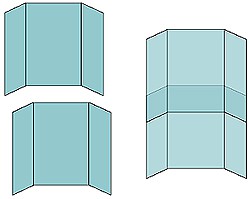
|

|
|
This board is the ultimate in simplicity: slide one board over the other until you
have just the amount of space you need.
One minor disadvantage—while the board is assembled, you cannot fold the flaps to lie flat. You must disassemble the board to do that. |
A board constructed with the vertical overlap technique. |
Stacked |
|
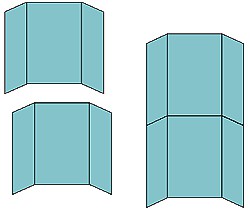
|
Simply stack one board on top of another. Cut one or both boards to the appropriate length if you don't want the board to be this tall. |
Horizontal Overlap |
|
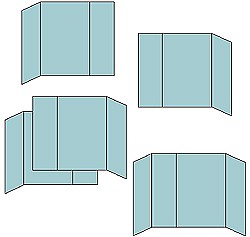
|
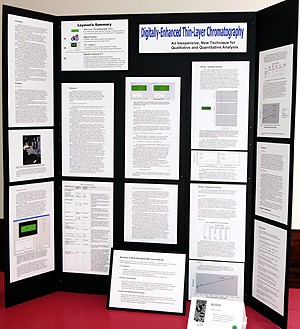
|
| This example is horizontally overlapped and stacked for a total size, if laid flat, of 60" (1.5 m) wide by 52" (1.3 m) tall. When standing on a table, as shown, it is 48" (1.2 m) wide from tip to tip. Note that it also utilizes a small "buddy board." | |
Modular Board Construction Techniques
Cutting Your Board |
Using Bolts |
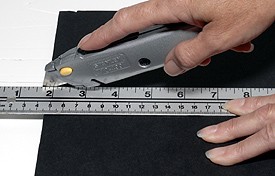
|
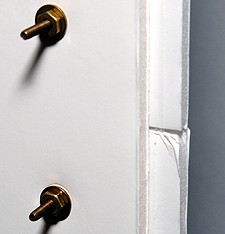
|
|
If you need to reduce the size of a board, use a box cutter guided by and up against a straightedge.
Generally it's best to make more than one pass rather than trying to cut through the foam core all at once. Be sure to put heavy cardboard or scrap foam core underneath the board you are cutting to protect your cutting surface.
Unless you are really good at cutting, you may find it best to mate the uncut (and straightest) edges against each other when you assemble your board. |
The best way to hold a modular board together is by using small nuts and bolts. #4 size bolts are plenty strong, but may be hard to find. Using #6 or #8 bolts will be fine; make sure they are at least 3/4 inch (2 cm) long for bolting together two pieces of standard foam core.
Use a nail or an awl to make holes for the bolts. |
Stacked Board Assembly |
Tape Techniques |
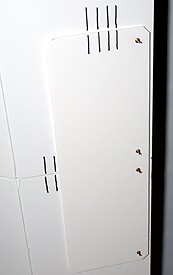
|
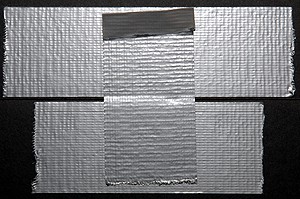
|
| For a stacked board, you can use strips of foam sheets to connect the two pieces. On a stacked board, you can also use heavy packaging tape or duct tape. | Heavy packaging tape or duct tape is also useful for board assembly. Unfortunately, once you put tape on cardboard or foam core, it won't come off without destroying the board. The solution is to put down a layer of tape that you don't ever take off, then attach the tape you want to remove at disassembly time on top of this layer. Fold one end under to make it even easier to remove. |
Tips!
- When printing out the material for your board, be sure to keep in mind where your board "breaks" between the different panels you construct it from. Sometimes it's helpful to do a quick printout to check the layout.
- Be sure to assemble your board at least once before taking it to your event. That way you can debug any problems you find.
Other Considerations for Display Boards at Top Fairs
Many of the top fairs have stringent rules for display boards (check your fair rules for specifics):
- Some fairs require the display of an official abstract.
- Some fairs require sources or credits for all images.
- Some fairs prohibit certain kinds of images.
- While not an official rule, at most top fairs you should make sure that each of your figures, pictures, images, and tables are numbered and have captions. When referring to the figures in your text, always use the number. This is the way it is done in scientific literature, and if possible, you should copy the style of a scientific journal in your area of study.




